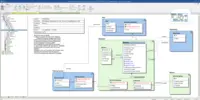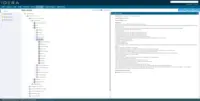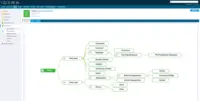Overview
What is ER/Studio Data Architect?
ER/Studio is a database development and management tool from Embarcadero Technologies (acquired by Idera) in California.
Pricing
Entry-level set up fee?
- No setup fee
Offerings
- Free Trial
- Free/Freemium Version
- Premium Consulting/Integration Services
Starting price (does not include set up fee)
- $1,470.40 one-time fee per user
Product Demos
Governing data with ER/Studio Data Architect
Product Details
- About
- Integrations
- Competitors
- Tech Details
- Downloadables
- FAQs
What is ER/Studio Data Architect?
ER/Studio Data Architect is a data architecture and database design software. It is compatible with multiple database platforms. The tool is used to create and manage database designs, as well as to document and reuse data assets. It aims to enable companies to create and maintain entity relationship diagrams with detailed metadata.
ER/Studio Data Architect offers several benefits, including:
Round-trip database support: Data architects can reverse-engineer, analyze, and optimize existing databases from diverse platforms. Such platforms include relational and NoSQL data sources.
Collaborate and share: Multiple users can collaborate and share data assets across modeling projects in the model repository.
Design a business-driven enterprise data architecture: ER/Studio Data Architect enables companies to design a data architecture that is aligned with their business needs.
Enforce organizational standards: The tool enforces organizational standards in data modeling throughout the organization.
Manage hierarchical models such as JSON, MongoDB, Google BigQuery in the same way and graphical user interface as relational models.
ER/Studio Data Architect is designed for a variety of professionals who are involved in data modeling, database design, and data management. These professionals include:
Data architects can use ER/Studio Data Architect to create and maintain entity relationship diagrams, as well as to document and reuse data assets.
Database administrators can use the tool to reverse-engineer, analyze, and optimize existing databases, ensuring optimal performance and compliance with organizational standards.
Data analysts can use ER/Studio Data Architect to understand and analyze data structures, relationships, and metadata across different data sources.
Data modelers can leverage the tool to design and maintain logical and physical data models for various database platforms.
Developers can use ER/Studio Data Architect to generate and change database schema scripts, ensuring consistency between the data model and the actual database.
Business analysts can use the tool to understand and document business requirements and data needs, facilitating better collaboration between business and information technology teams.
The top use cases of ER/Studio Data Architect are:
Analyze and design platform-independent logical data architecture.
Design and construct platform-specific physical databases.
Build and maintain large, complex database applications.
Consolidate, report, and re-use metadata across the enterprise.
Describe information requirements and technical design of data assets.
Understand and design data assets in a universal way without having to understand code.
Control how changes in requirements are implemented.
Allow data architects to support a data governance program.
The top strengths of ER/Studio Data Architect are:
Broad range of database platform support.
Enterprise-level capabilities.
Visual data lineage and flow modeling.
Full dimensional modeling for data warehousing and business intelligence.
Business data objects to bridge the gap between developers and data architects.
Agile change management, nested submodels, and universal mappings.
Superior compare and merge.
Built-in business glossary.
Rich macros supported by full programming language.
ER/Studio Data Architect Features
- Supported: Builds out an enterprise data model as entity relationship diagrams (ERD)
- Supported: Creates a data catalog to support data governance initiatives, and metadata management
- Supported: Discovers and documents existing data assets
- Supported: Lays the foundation for robust data governance and data management
ER/Studio Data Architect Screenshots
ER/Studio Data Architect Video
ER/Studio Data Architect Integrations
- Collibra Data Intelligence Cloud
- WhereScape 3D
- Bluemetrix Data Manager
- Silwood Safyr
ER/Studio Data Architect Competitors
ER/Studio Data Architect Technical Details
| Deployment Types | On-premise |
|---|---|
| Operating Systems | Windows |
| Mobile Application | No |
| Supported Languages | English |





